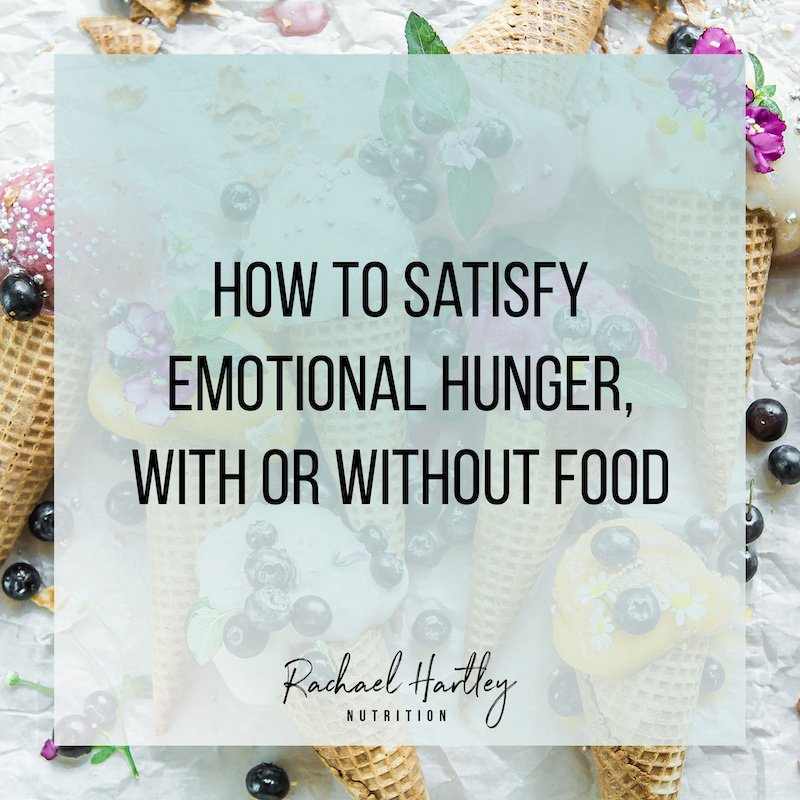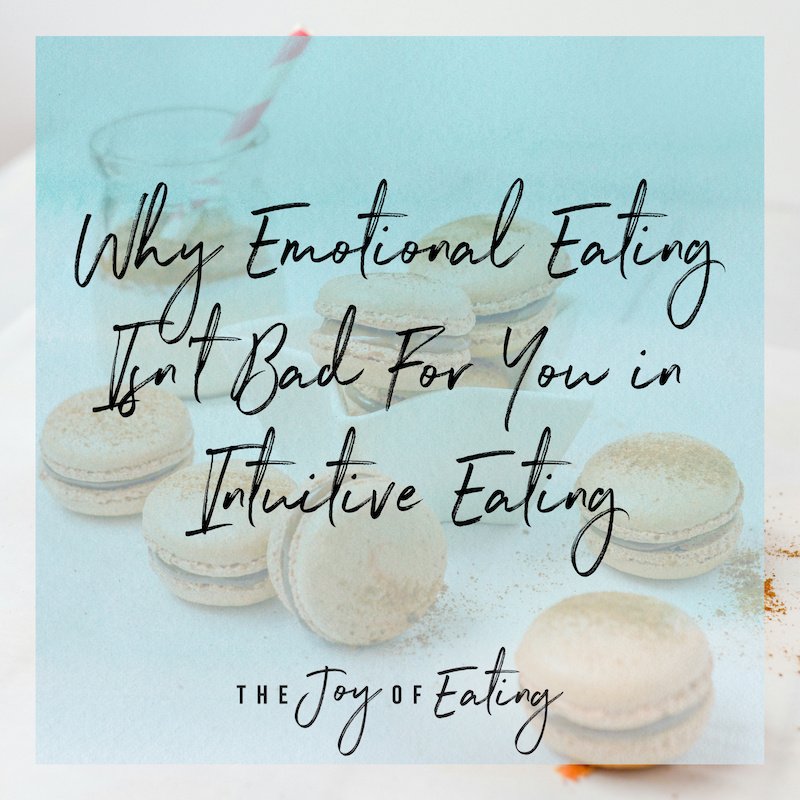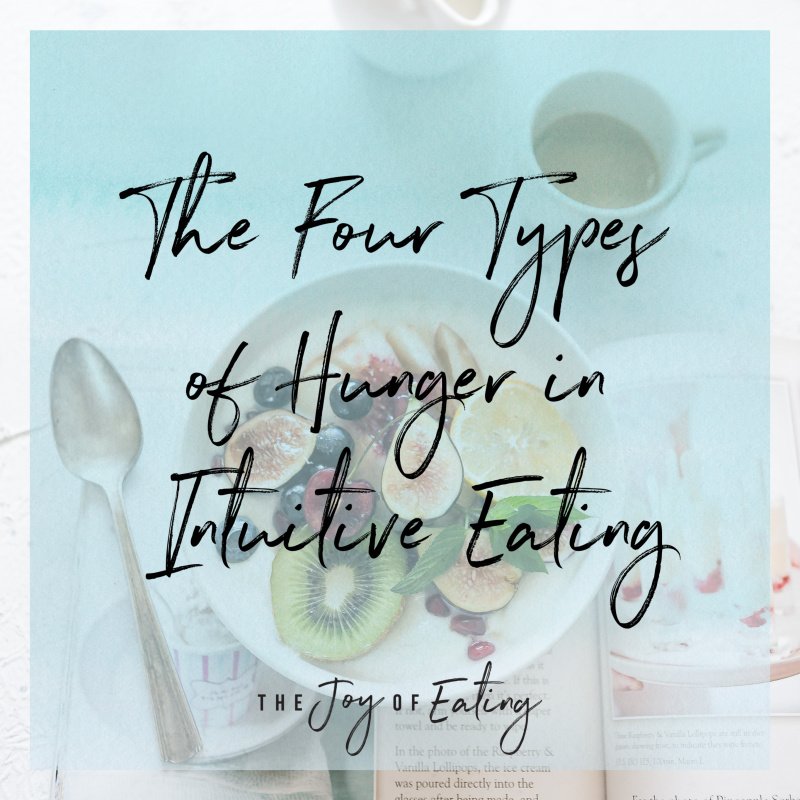How To Satisfy Emotional Hunger, With Or Without Food
Emotional eating may get a bad rep, but food is one way of satisfying emotional hunger. The problem comes when it’s the only coping tool in your arsenal. Read this blog post to get more ideas for how to cope with intense emotions, with or without food.
In last week’s post on emotional hunger vs. physical hunger, and in my previous post on the four types of hunger in intuitive eating, I discussed the concept of emotional hunger - when you aren’t physically hungry, but desire food to cope with an intense emotion. Food has an effect on our mood, by stimulating the release of hormones like dopamine and serotonin. It can also tap into happy memories, or simply serve as a distraction from feelings that feel impossible to sit with. We satisfy emotional hunger with food because, well, it works.
Still, emotional eating gets a bad rep. People talk about diving into a box of cookies when you're feeling sad like it's on par with stealing a kids bicycle or kicking a puppy. Humans are emotional beings, and we're designed to get pleasure from food. It's impossible to separate food from emotion. And emotionless eating? Now that doesn't sound like much fun, does it?
Food is one way to cope with intense emotions. It’s not wrong or bad to satisfy emotional hunger with food. Instead of trying to stop emotional eating, we work with our clients teaching them how to build a well rounded set of tools for satisfying emotional hunger - a toolbox that includes food, but also other self care tools. Because while food is soothing in the short term, it’s essentially the duct tape of self care - great for quick fixes but usually not the tool that gets at the heart of what’s going on. By creating a self care toolbox, you have multiple tools to decide what is most effective and most accessible at any given time.
Even if you’re convinced emotional eating is a bad way to cope with emotions, telling yourself emotional eating is wrong doesn’t exactly help you do less of it! It simply fuels more shame around the behavior, which leads to more emotional eating. It might sound counterintuitive, but giving yourself permission to emotionally eat can actually help loosen its grip.
How to Satisfy Emotional Hunger, With or Without Food:
Here’s some ideas for tools you can put in your toolbox for satisfying emotional hunger.
Anger:
Eat something crunchy, like chips or nuts (highly recommend turbinado and sea salt dark chocolate almonds from Trader Joe's)
Vent to someone you trust. It's good to have someone outside of the situation that you can talk to.
Punch a punching bag. Throw pillows against the wall. Slam a door. Curse. Let yourself express some of that anger in a safe way.
Write a letter or email to the person you're mad at. Probably best not to hit send.
Sad/depressed:
Watch an episode of a warm, funny TV show if you feel like being cheered up, like Unbreakable Kimmie Schmidt, The Good Place, or Abbott Elementary. Personally, I find that when I’m feeling sad, I like to watch shows with dark humor and themes about loneliness and connection, like Only Murders in the Building and Bojack Horseman.
Fix a big bowl of ice cream with colorful sprinkles.
Look at pictures of Bernese Mountain Dog puppies on instagram. Obviously you can follow my baby angel @TheRoseBern. My friends and family and I all follow @BerneseMountainDogLovers, @BerneseDaily, @WaffleNugget, and @Luna.the.Berner and basically know all the insta-famous Berners by name, and talk about their instagrams like they're the Kardashians or something. Certainly you can follow other dog breeds, but let’s be honest, Berners are a hit of pure serotonin.
See, pure serotonin
Go outside and get a little sun. Alternatively, put on cozy PJs, crawl into bed and have a nice cry.
Make an appointment with a therapist to chat things out, or your doctor to discuss medication. No shame in the medication game.
Anxiety:
Go to a yoga class or do a video at home. I'm a big fan of Body Positive Yoga on YouTube.
Go for a mindful walk outside. Notice the sky, flowers, details on the houses. Pay attention to how it feels when your feet hit the pavement. Feel the breeze hit your body. Engage your senses as much as possible.
When I go for mindful walks, I like to notice how the flowers change throughout the spring, summer and fall, especially now that we live in Boston and the flowers are so different from SC!
Practice a deep breathing exercise. Check out the free app Insight Timer for guided meditations and deep breathing exercises.
Eat a bowl of shell-on pistachios. Something about cracking them helps me with anxiety.
Listen to calming music. Put on a yoga or meditation playlist on Pandora.
Loneliness:
Call or text with a friend or family.
Make plans with a friend or colleague to go out and get a glass of wine or coffee.
Was really missing my friends from home, and was able to text a friend and plan a random meetup in NYC when she was there with family!
Go to a local coffee shop to read or work around other people. Enjoy a fancy drink and/or a pastry while you're there. Perhaps even strike up a conversation with someone nearby? If you have a dog, hang out at a brewery or restaurant with a dog friendly patio - since moving to Boston, we’ve met a ton of friends that way!
Read a book with a protagonist you feel connected with.
Find a place to volunteer where you'll be with other people.
Boredom:
Try to learn the dance routine to a favorite pop song. The Fitness Marshall is really fun for this!
Bake something. You can throw together a simple recipe, like some basic chocolate chip cookies, or go all out and bake the most extravagant cake recipe you can find. Might I suggest this passion fruit, white chocolate and coconut layer cake I’ve been eyeballing?
Not my picture, but this salty pear honey pie has been my favorite baking project lately. From Hello my Dumpling.
Research a random topic you’re interested in – dive deep into that Wikipedia black hole! A few recent topics that might pique your interest: King Pedro and Ines of Portugal (the historic inspiration for Romeo and Juliet), how a random organ in your body works (research the kidney and you will be forever occupied), or a crime from your hometown.
Plan your next vacation - or dream vacation! When we travel, I like to create a google map of all the sites and restaurant recommendations we get, and it’s a fun thing to do when I’m bored.
Work on a project that's been lingering on your to do list, either at home or for work. If you can’t think of anything, knock on my door and I'll put you to work 😉
Grief:
Let yourself cry. Let yourself be angry. Wherever you’re at in the stages of grief is OK to be.
Depending on if/where you worship or feel a spiritual connection, go to temple, mosque, church, synagogue, or a tranquil place outdoors.
Find a support group or talk to a friend/family member who understands your loss.
Make or order a food that reminds you of the person you're missing. One of my clients who recently lost a family member started cooking his way through a family cookbook, and it was really healing for him.
Volunteer in a way that connects you to what you're grieving. If it's a pet, consider volunteering at a shelter. If it's a person, volunteer with an organization that was meaningful to them.
Satisfy emotional hunger with intention.
All of the above are ideas for satisfying different kinds of emotional hunger, and they may or may not resonate with you. I’d encourage you to think up your own lists, and try to fill it with activities/coping tools that are accessible. Keep in mind if you are struggling with binge eating disorder or have a trauma history, especially if you are early on in your healing, there might not be a lot of other coping tools you can think of. Thats OK. You are allowed to turn to food as you work on expanding your toolbox - and after! Food is not a wrong choice, but when it’s the reflexive choice, it can prevent you from exploring other, possibly more effective tools.
No matter what tool you use to satisfy emotional hunger, whether it involves food or not, I’d encourage you to practice making that choice consciously, and engaging with that coping strategy with intention. This is especially true when using food to soothe, as giving yourself permission takes away a lot of the shame that fuels binge eating. Think about the different in how it might feel to eat ice cream in front of the open freezer standing up, versus putting it in a bowl, sitting in your favorite comfy chair and wrapping up with a cozy blanket, and savoring it. Giving yourself permission allows for you to actually enjoy and taste the food you’re eating, and let’s it actually soothe your emotions a bit!
If you struggle with emotional or binge eating, I hope this blog post was helpful for you in providing a different way of looking at emotional eating, and some tangible tools for navigating it. If you feel like you need one on one support for navigating emotional or binge eating, we work with clients throughout the US providing intuitive eating coaching to help you foster a healthier relationship with food in a supportive, empathetic environment. Click here to learn more about our practice philosophy here, and reach out if you are interested in working together.
This blog post on satisfying emotional hunger was originally published April 2018 and has been updated to give you the best possible content.










